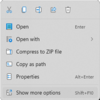Memory exception and Guard Page exception
Crash and task bar disappears, reloads sometimes
Most of the time no taskbar
Crash and task bar disappears, reloads sometimes
Most of the time no taskbar
- Windows Build/Version
- 21H2 Build 22000.593
My Computer
System One
-
- OS
- Win11,Win10, Win7, Ubuntu, Fedora, etc...
- Computer type
- PC/Desktop
- Manufacturer/Model
- Me
- CPU
- AMD Ryzen 9 3950X
- Motherboard
- MEG X570 GODLIKE
- Memory
- G.Skill F4-3600C18-32GVK DDR4 x 2
- Graphics Card(s)
- AMD Radeon RX 5700XT
- Monitor(s) Displays
- MSI
- Screen Resolution
- 3840x2160
- Hard Drives
- WDC WDS200TB0B-00YS70
ST80000DM004-2CX188
Samsung 970 EVO 500GB
- PSU
- Seasonic PX1300
- Case
- lian li
- Cooling
- NZXT
- Keyboard
- Logitech G213
- Mouse
- Logitech G602
- Internet Speed
- 1G
- Browser
- Brave
























